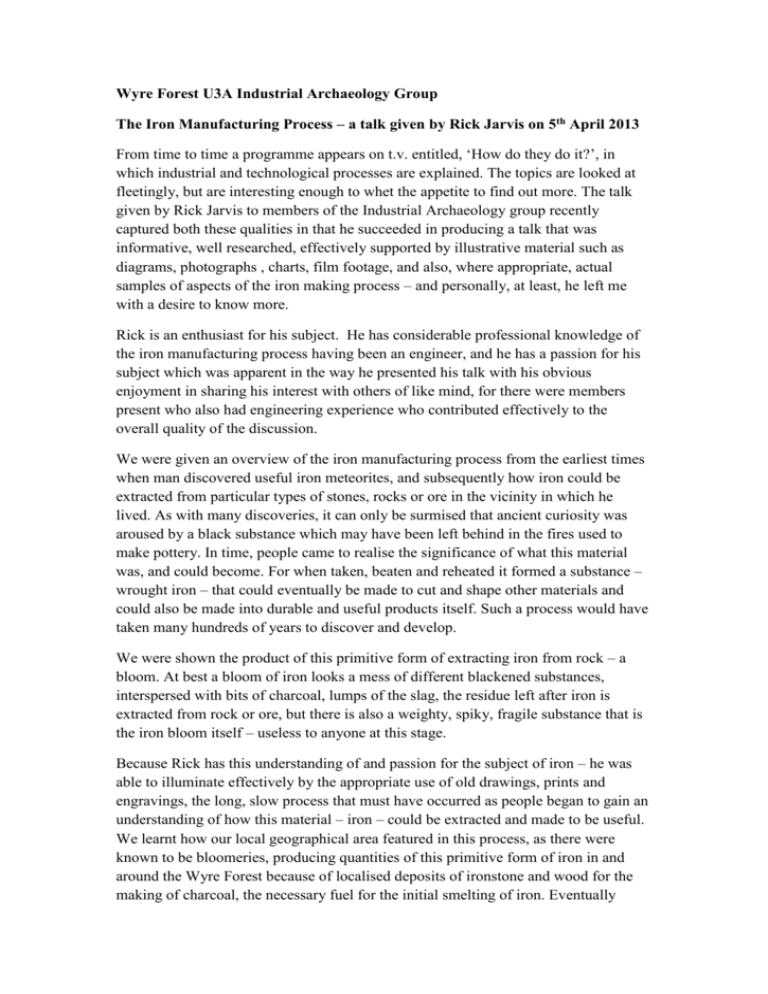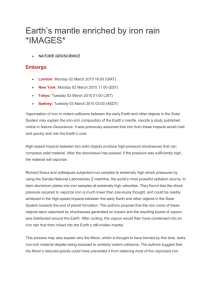Rev_RJ_talk_on_iron_mfg
advertisement

Wyre Forest U3A Industrial Archaeology Group The Iron Manufacturing Process – a talk given by Rick Jarvis on 5th April 2013 From time to time a programme appears on t.v. entitled, ‘How do they do it?’, in which industrial and technological processes are explained. The topics are looked at fleetingly, but are interesting enough to whet the appetite to find out more. The talk given by Rick Jarvis to members of the Industrial Archaeology group recently captured both these qualities in that he succeeded in producing a talk that was informative, well researched, effectively supported by illustrative material such as diagrams, photographs , charts, film footage, and also, where appropriate, actual samples of aspects of the iron making process – and personally, at least, he left me with a desire to know more. Rick is an enthusiast for his subject. He has considerable professional knowledge of the iron manufacturing process having been an engineer, and he has a passion for his subject which was apparent in the way he presented his talk with his obvious enjoyment in sharing his interest with others of like mind, for there were members present who also had engineering experience who contributed effectively to the overall quality of the discussion. We were given an overview of the iron manufacturing process from the earliest times when man discovered useful iron meteorites, and subsequently how iron could be extracted from particular types of stones, rocks or ore in the vicinity in which he lived. As with many discoveries, it can only be surmised that ancient curiosity was aroused by a black substance which may have been left behind in the fires used to make pottery. In time, people came to realise the significance of what this material was, and could become. For when taken, beaten and reheated it formed a substance – wrought iron – that could eventually be made to cut and shape other materials and could also be made into durable and useful products itself. Such a process would have taken many hundreds of years to discover and develop. We were shown the product of this primitive form of extracting iron from rock – a bloom. At best a bloom of iron looks a mess of different blackened substances, interspersed with bits of charcoal, lumps of the slag, the residue left after iron is extracted from rock or ore, but there is also a weighty, spiky, fragile substance that is the iron bloom itself – useless to anyone at this stage. Because Rick has this understanding of and passion for the subject of iron – he was able to illuminate effectively by the appropriate use of old drawings, prints and engravings, the long, slow process that must have occurred as people began to gain an understanding of how this material – iron – could be extracted and made to be useful. We learnt how our local geographical area featured in this process, as there were known to be bloomeries, producing quantities of this primitive form of iron in and around the Wyre Forest because of localised deposits of ironstone and wood for the making of charcoal, the necessary fuel for the initial smelting of iron. Eventually discoveries were made as to how the iron blooms could be reheated, repeatedly beaten and used in the process of making strong versatile wrought iron – how as bloomeries got bigger with more powerful air blast, the bloomeries developed into blast furnaces producing "pig iron" - how artisans strove to develop fineries to convert brittle pig iron into the wrought iron needed by blacksmiths. In time another reasonably local product – limestone, was found to be useful as a component in the smelting process to rid the pig iron of some of its impurities, thereby resulting in a better quality iron. By the time of the early 18th century it was found that coke, a by product of coal, was found to be a cheaper alternative to the fast disappearing charcoal, this occurred in nearby Coalbrookdale. We learned how by "puddling" molten pig iron with long bars in special furnaces, coke could be used to coax carbon and impurities out of the pig iron to produce quantities of lower cost high grade wrought iron. Local geographical features were harnessed to the development of iron manufacture. The many streams of the area often drove water wheels which in turn worked bellows that blasted air into the furnaces, or raised the heat of the forges working the iron, and powered the drop hammers that were used to shape the malleable iron or power rollers for shaping it into bars for producing strips, wire and nails So it was that because of the amenities available locally, the iron manufacturing industry began to settle and develop in what we now call, ‘the Black Country’, the counties of Staffordshire, North Worcestershire and Warwickshire. Initially there was plenty of wood from which to make charcoal, later plenty of coal, from which to make coke, plenty of limestone to be used in purifying the iron during smelting, plenty of water to drive water wheels to work bellows, hammers and rollers and later transport iron to where it could be worked and processed. At one time in the 17th century, the River Stour and its tributaries was considered to be the most industrialised river in the country, having over 100 iron works making use of its water and power. Eventually canals would carry raw materials to where they were needed, but importantly they would also carry iron goods for export, down the StaffordshireWorcestershire canal – one of the first canals to be built, then via the River Severn to Bristol and the world. Report by Mike Carter







